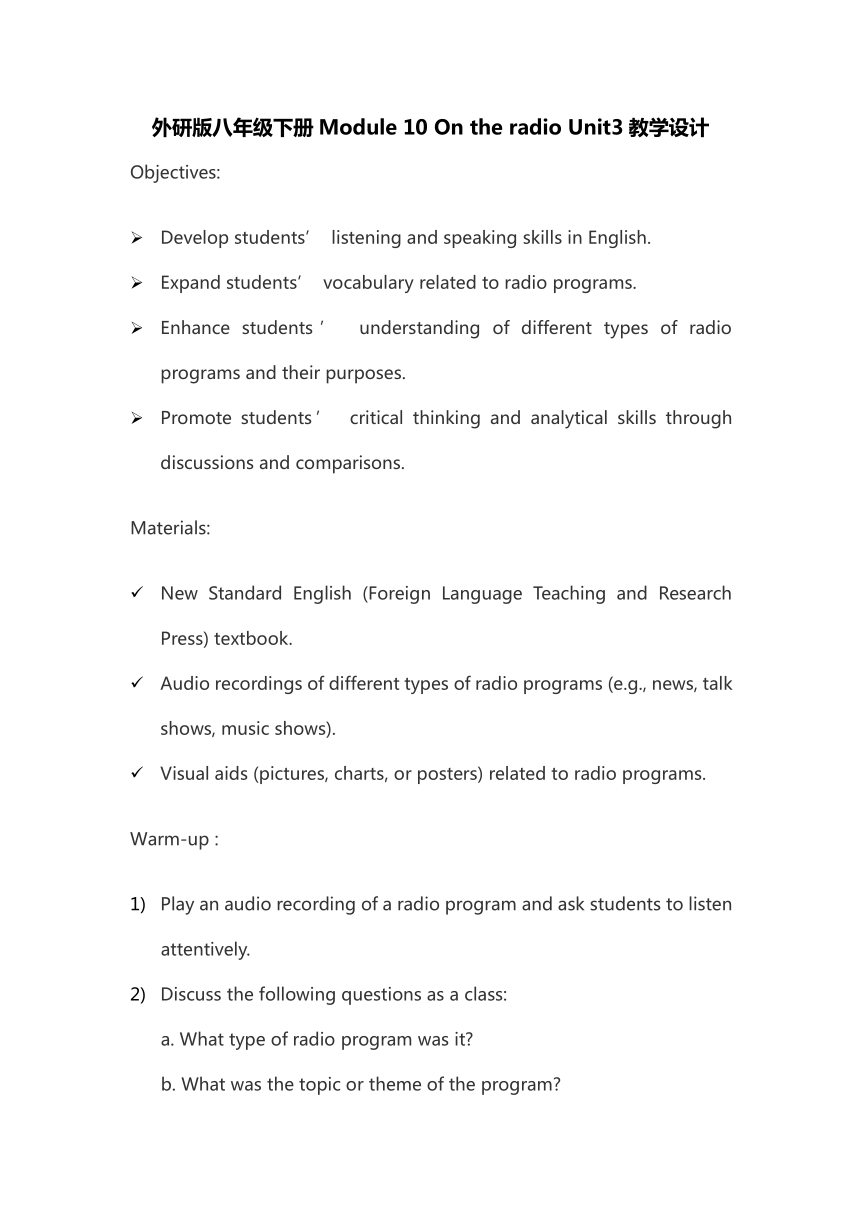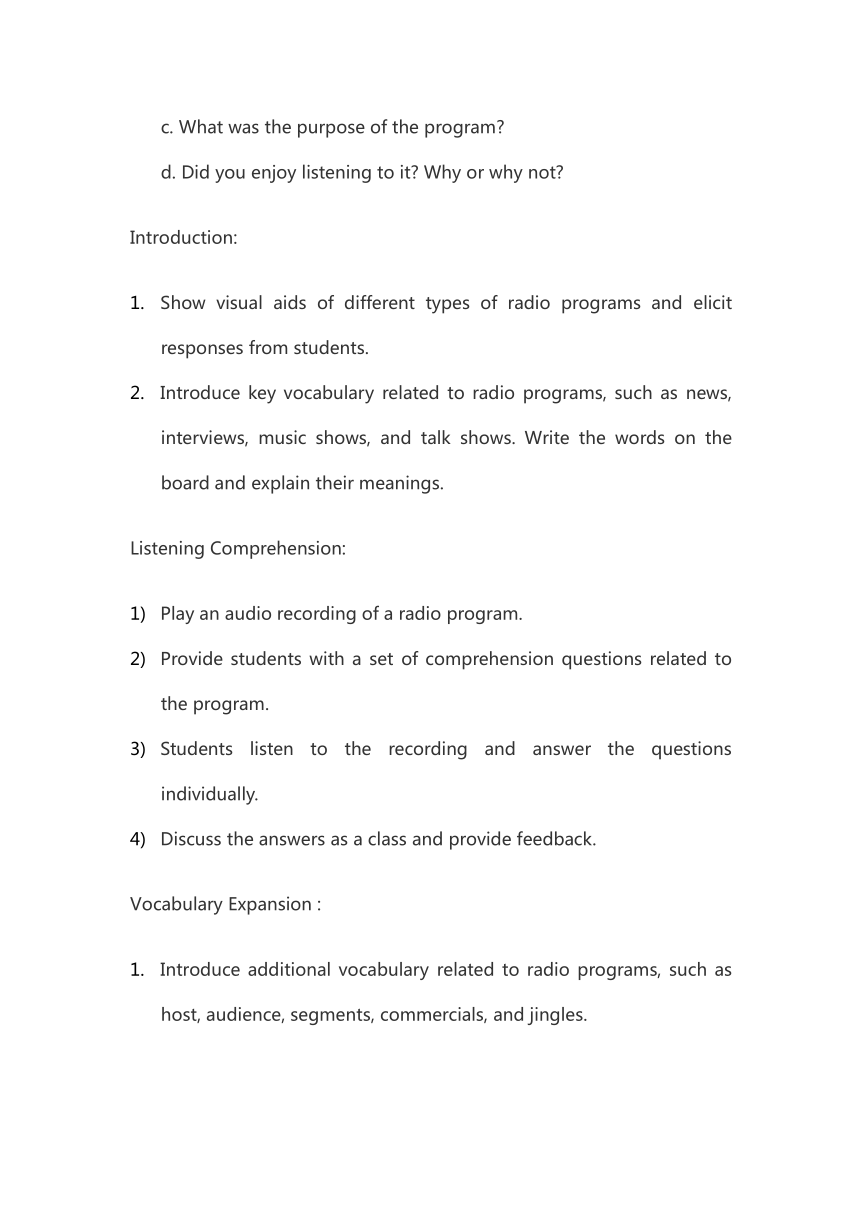Module 10 On the radio Unit3教学设计2022-2023学年外研版八年级英语下册
文档属性
| 名称 | Module 10 On the radio Unit3教学设计2022-2023学年外研版八年级英语下册 |  | |
| 格式 | docx | ||
| 文件大小 | 17.7KB | ||
| 资源类型 | 教案 | ||
| 版本资源 | 外研版 | ||
| 科目 | 英语 | ||
| 更新时间 | 2023-08-05 08:58:11 | ||
图片预览


文档简介
外研版八年级下册Module 10 On the radio Unit3教学设计
Objectives:
Develop students’ listening and speaking skills in English.
Expand students’ vocabulary related to radio programs.
Enhance students’ understanding of different types of radio programs and their purposes.
Promote students’ critical thinking and analytical skills through discussions and comparisons.
Materials:
New Standard English (Foreign Language Teaching and Research Press) textbook.
Audio recordings of different types of radio programs (e.g., news, talk shows, music shows).
Visual aids (pictures, charts, or posters) related to radio programs.
Warm-up :
Play an audio recording of a radio program and ask students to listen attentively.
Discuss the following questions as a class:
a. What type of radio program was it
b. What was the topic or theme of the program
c. What was the purpose of the program
d. Did you enjoy listening to it Why or why not
Introduction:
Show visual aids of different types of radio programs and elicit responses from students.
Introduce key vocabulary related to radio programs, such as news, interviews, music shows, and talk shows. Write the words on the board and explain their meanings.
Listening Comprehension:
Play an audio recording of a radio program.
Provide students with a set of comprehension questions related to the program.
Students listen to the recording and answer the questions individually.
Discuss the answers as a class and provide feedback.
Vocabulary Expansion :
Introduce additional vocabulary related to radio programs, such as host, audience, segments, commercials, and jingles.
Use context sentences or visual aids to help students understand the new words.
Engage students in vocabulary activities, such as matching the words with their meanings or using them in sentences.
Group Discussion :
Divide students into groups of 3-4.
Assign each group a different type of radio program (e.g., news, talk show, music show).
In their groups, students discuss and analyze their assigned type of radio program.
What are the characteristics of this type of program
Who is the target audience
What is the purpose of the program
What are some examples of popular programs in this category
Each group presents their findings to the class.
Comparing Radio Programs :
Show visual aids or provide descriptions of two different radio programs (e.g., a news program and a music show).
Ask students to compare and contrast the two programs based on their characteristics, target audience, and purposes.
Facilitate a class discussion on the similarities and differences between the programs.
Encourage students to express their opinions and support them with arguments.
Conclusion:
Summarize the key points discussed during the lesson.
Recap the different types of radio programs and their purposes.
Provide opportunities for students to ask questions or share their reflections.
Extension Activity :
Ask students to create their own radio program, either individually or in groups.
Students can choose a type of program, come up with a theme, plan segments or content, and present a brief synopsis to the class.
Objectives:
Develop students’ listening and speaking skills in English.
Expand students’ vocabulary related to radio programs.
Enhance students’ understanding of different types of radio programs and their purposes.
Promote students’ critical thinking and analytical skills through discussions and comparisons.
Materials:
New Standard English (Foreign Language Teaching and Research Press) textbook.
Audio recordings of different types of radio programs (e.g., news, talk shows, music shows).
Visual aids (pictures, charts, or posters) related to radio programs.
Warm-up :
Play an audio recording of a radio program and ask students to listen attentively.
Discuss the following questions as a class:
a. What type of radio program was it
b. What was the topic or theme of the program
c. What was the purpose of the program
d. Did you enjoy listening to it Why or why not
Introduction:
Show visual aids of different types of radio programs and elicit responses from students.
Introduce key vocabulary related to radio programs, such as news, interviews, music shows, and talk shows. Write the words on the board and explain their meanings.
Listening Comprehension:
Play an audio recording of a radio program.
Provide students with a set of comprehension questions related to the program.
Students listen to the recording and answer the questions individually.
Discuss the answers as a class and provide feedback.
Vocabulary Expansion :
Introduce additional vocabulary related to radio programs, such as host, audience, segments, commercials, and jingles.
Use context sentences or visual aids to help students understand the new words.
Engage students in vocabulary activities, such as matching the words with their meanings or using them in sentences.
Group Discussion :
Divide students into groups of 3-4.
Assign each group a different type of radio program (e.g., news, talk show, music show).
In their groups, students discuss and analyze their assigned type of radio program.
What are the characteristics of this type of program
Who is the target audience
What is the purpose of the program
What are some examples of popular programs in this category
Each group presents their findings to the class.
Comparing Radio Programs :
Show visual aids or provide descriptions of two different radio programs (e.g., a news program and a music show).
Ask students to compare and contrast the two programs based on their characteristics, target audience, and purposes.
Facilitate a class discussion on the similarities and differences between the programs.
Encourage students to express their opinions and support them with arguments.
Conclusion:
Summarize the key points discussed during the lesson.
Recap the different types of radio programs and their purposes.
Provide opportunities for students to ask questions or share their reflections.
Extension Activity :
Ask students to create their own radio program, either individually or in groups.
Students can choose a type of program, come up with a theme, plan segments or content, and present a brief synopsis to the class.
同课章节目录
- Module 1 Feelings and impressions
- Unit 1 It smells delicious.
- Unit 2 I feel nervous when I speak Chinese .
- Unit 3 Language in use
- Module 2 Experiences
- Unit 1 I've also entered lots of speaking competi
- Unit 2 They have seen the Pyramids.
- Unit 3 Language in use
- Module 3 Journey to space
- Unit 1 Has it arrived yet?
- Unit 2 We have not found life on any other planet
- Unit 3 Language in use
- Module 4 Seeing the docto
- Unit 1 I haven't done much exercise since I got m
- Unit 2 We have played football for a year now
- Unit 3 Language in use
- Module 5 Cartoons
- Unit 1 It's time to watch a cartoon.
- Unit 2 Tintin has been popular for over eighty yea
- Unit 3 Language in use
- Revision module A
- Module 6 Hobbies
- Unit 1 Do you collect anything ?
- Unit 2 Hobbies can make you grow as a person.
- Unit 3 Language in use
- Module 7 Summer in Los Angeles
- Unit 1 Please write to me and send me some photos
- Unit 2 Fill out a form and come to learn English
- Unit 3 Language in use
- Module 8 Time off
- Unit 1 I can hardly believe we are in the city ce
- Unit 2 We thought somebody was moving about
- Unit 3 Language in use
- Module 9 Friendship
- Unit 1 Could I ask if you've mentioned this to he
- Unit 2 I believe that the world is what you think
- Unit 3 Language in use
- Module 10 On the radio
- Unit 1 I hope that you can join us one day
- Unit 2 It seemed that they were speaking to me in
- Unit 3 Language in use
- Revision module B
